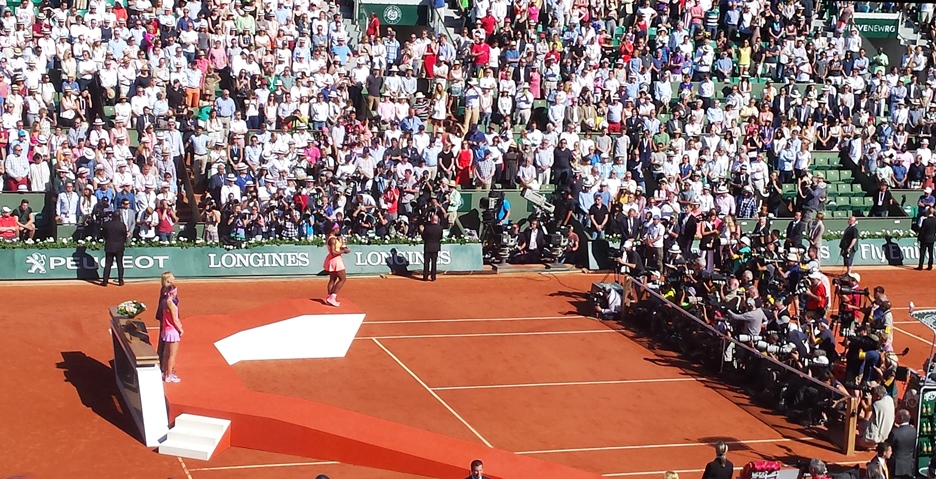Coming into today’s final match, the head-to-head record between Serena Williams and Lucie Safarova was 8-0 in the American’s favor, for a very good reason. Williams is very good at forcing her opponents into a defensive position and demand that they produce a high-level, counterpunch-style tennis. Lo and behold, that happens to be exactly what carries Safarova through most of her wins: the ability to set her feet, shift the shoulders forward to produce some penetrating winners from both sides. Let’s simplify the equation: what Serena does very well, single-handedly negates Lucie’s biggest weapon and ruins the core of the Czech’s plan A.
If you have access to the replay of the match, and you want to see the type of damage that Safarova can inflict on her opponents when she gets her feet set, watch the two points from 30-0 to 30-30 at 4-2 in the first set. Another good example is the first point of the 3-1 game in which Lucie struck three good shots in a row, pushed Serena around, and finally won the point. Now, if you want a great contrast to that last example, watch the following point at 15-0. In that long point, Lucie stays in control for several shots but can’t put it away; then Serena counterpunches with her forehand hard to the cross-court corner and puts Lucie on the run. Next (and yes, you guessed it), Lucie misses the very first shot (a backhand) that she has to hit on the stretch from the outside the boundaries of the singles lines. A second example of the same contrast happened also at 5-5 and 15-0 in the second set, with Safarova serving. During the majority of that long point, the ball traveled back and forth at high speed, yet remained mostly within the singles line, which allowed Lucie to hang tough. However, as soon as Serena hit a hard, sharp cross-court shot and pushed Safarova out to the doubles alley, the Czech had to stretch and float the shot back, which then allowed Serena to hit the winner to the open court.
These are only a couple of examples of why Serena had more trouble against Victoria Azarenka, Sloane Stephens, and Timea Bacsinszky. They could counterpunch Serena’s power with accuracy and speed when they were put on the run. Serena still ended up winning because she has superior skills and, this next one is ex-cathedra, she can raise her game when needed. Azarenka can power back Serena’s shot and surprise her, Stephens and Bacsinsky can hit backhands and forehands on the stretch, generating power with the flick of their wrists (especially Bacsinszky on the backhand side). Safarova, on the other hand, is not the speediest player moving side-to-side, which is an oddity considering how exceptional her movement is around the ball, in place, using quick and small steps (reminds me of Andre Agassi).
You are probably saying to yourself “Wait, did you watch the match? Lucie went three sets too!” My response to you would be, don’t let the second set fool you. This match was never out of Serena’s control. Safarova got back in the set only because Williams began to commit double faults and few untimely errors out of nowhere. It also helped Safarova that throughout the comeback in the second set, from 1-4 down to winning the tiebreaker, the Chatrier crowd got behind her (they chanted her name in two different versions: “Lucie” the French version, “Lu-zi-yé” the Czech version!)
Yet, the main plot remained untouched. When Safarova served her only double fault of the match at 2-1, and 30-40, and lost the early break, one could sense that it was the beginning of the end for the Czech. It was confirmed the next time Serena had a break point, two games later, up 3-2. The players engaged in a rally, and the original pattern ensued, with Serena collecting a mistake from Safarova the first time she pushed her to the outside of the court.
There are three types of matches that end lopsided. First case is when both players play the same style, and one does everything a little better than the other (Nadal-Ferrer on clay comes to mind). Second case is when one player’s weakness plays into the strength of the other, or vice-versa. Third is when a player, for one reason or another, decides not to put forth any effort to win (there are plenty examples of this in the past, you pick your own). Today’s case would have fit the second one if it were not for an extended period of meltdown by the American in the middle portion of the match.
Now Serena Williams stands at 20 Major titles, only second to Steffi Graf’s 22. This could also be the year in which she achieves the Grand Slam, the only elite accomplishment that is still not in her résumé. She is 33 years old, but still rules the W.T.A. arena, and there is no reason to think that both accomplishments are not within her reach.

Note: Follow Mertov’s Tennis Desk on Twitter for frequent live updates from Roland Garros
